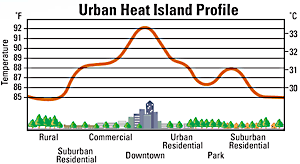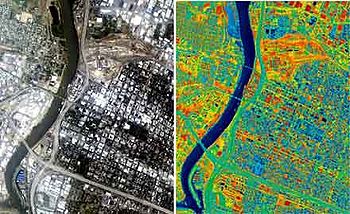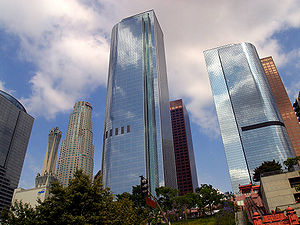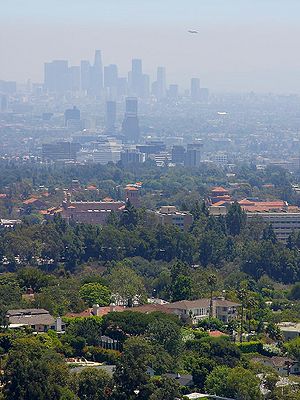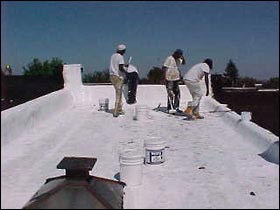Heat island
Heat island refers to urban air and surface temperatures that are higher than nearby rural areas. Many cities and suburbs have air temperatures that are 2 to 10°Fahrenheit (1 to 6°Celsius) warmer than the surrounding natural land cover. Figure 1 shows a city's heat island profile. It demonstrates how urban temperatures are typically lower at the urban-rural border than in dense downtown areas. The graphic also show how parks, open land, and bodies of water can create cooler areas. Elevated temperatures can impact communities in a number of ways. Elevated temperatures can impact communities by increasing peak energy demand, air conditioning costs, air pollution (Air pollution emissions) levels, and heat-related illness and mortality. Heat islands also affect urban noise propagation in significant ways. Urban heat island effects can materially distort global thermal monitoring, particularly where expansion of a heat island encroaches on a sensor location previously established outside of a heat island.
The remotely sensed image of Sacramento, California in Figure 2 illustrates the heat island phenomenon. In the aerial photo (left), the white areas, mostly rooftops, are about 140 degrees Fahrenheit (60 degrees Celsius) and the dark areas, primarily vegetative areas or water, are approximately 85-96 degrees Fahrenheit (29-36 degrees Celsius).
Hottest spots are the buildings, seen as white rectangles of various sizes. In the thermal image (right), Sacramento's rail yard is the orange area east of the Sacramento River, which flows from top to bottom. Red and yellow areas indicate hot spots and generally correspond with urban development, while blue and green areas are cool and generally correspond to the natural environment.
Cities in cold climates may actually benefit from the wintertime warming effect of heat islands. Warmer temperatures can reduce heating energy needs and may help melt ice and snow on roads. In the summertime, however, the same city may experience the negative effects of heat islands.
Contents
Causes of heat islands
The reason the city is warmer than the country comes down to a difference between the energy gains and losses of each region. There are a number of factors that contribute to the relative warmth of cities:
- During the day in rural areas, the sunlight absorbed near the ground evaporates water from the vegetation and soil. Thus, while there is a net solar energy gain, this is compensated to some degree by evaporative cooling. In cities, where there is less vegetation, the buildings, streets and sidewalks absorb the majority of solar energy input.
- Because the city has less water, runoff is greater in the cities because the pavements are largely nonporous (except by the pot holes). Thus, evaporative cooling is less which contributes to the higher air temperatures.
- Waste heat from city buildings, cars and trains is another factor contributing to the warm cities. Heat generated by these objects eventually makes its way into the atmosphere (Atmosphere layers). This heat contribution can be as much as one-third of that received from solar energy (Sunlight).
- The thermal properties of buildings add heat to the air by conduction. Tar, asphalt, brick and concrete are better conductors of heat than the vegetation of the rural area.
- The canyon structure that tall buildings create enhances the warming. During the day, solar energy is trapped by multiple reflections off the buildings while the infrared heat losses are reduced by absorption.
- The urban heat island effects can also be reduced by weather phenomena. The temperature difference between the city and surrounding areas is also a function of the synoptic scale winds. Strong winds reduce the temperature contrast by mixing together the city and rural air.
- The urban heat island may also increase cloudiness and precipitation in the city, as a thermal circulation sets up between the city and surrounding region.
Heat islands can occur year-round during the day or night. Urban-rural temperature differences are often largest during calm, clear evenings. This is because rural areas cool off faster at night than cities, which retain much of the heat stored in roads, buildings, and other structures. As a result, the largest urban-rural temperature difference, or maximum heat island effect, is often three to five hours after sunset.
Distortion of historic data
A major problem caused by heat islands is their encroachment upon historic temperature sensors. The global network used for tracking worldwide temperature change, by definition, is a rather static network of thermal sensors; this is intentional so that one can portray a theoretical objective account of the time history of temperature. Howver, a major bias has become inherent, in that most of the sensors were placed seventy to 140 years ago in suburban or rural areas. At present most of these sensors have been subsumed into ever growing urban heat islands. Thus the portrayal of one degree temperature rise worldwide over the prior 140 years is a complete distortion and exaggeration of temperature rise. This is a considerable problem, in that some countries are placing large energy policy investments, based upon a fallacious assumption of exaggerated temperature increase.
Li and Zhao found that the urban heat island effect is responsible for between 0.14 and 0.25 degrees Celsius of the reported decadal termperature rise in meteorological reporting stations analyzed in China (Li and Zhao, 2012). Similarly Huang analyzed 41 meteorological stations in the Yangtze River basin and found that 0.18 to 0.48 degrees Celsius of reported temperature rise was attributed to urban heat island effects, and not atmospheric global warming. (Huang, 2015) The Huang study spanned the interval 1957 to 2013, the very period when global temperature reports showed the largest rise in global temperatures. Huang states that "Cities have a warmer climate than rural areas due to the urban heat island, which represents one of the most significant human-induced changes to earth’s surface climate". Raj et al. studied 44 major cities in India and concluded the urban heat island effect (not global warming) accounts for approximately 2 degrees Celsius rise in reported temperature rise. (Raj et el, 2020).
Zwang et al analyzed energy consumption in Asia and North America, concluding that anthropogenic energy sources (especially in Northern Hemispere winter) accounts for about 1.0 degrees Celsius of the reported global temperature rise of the last century in those regions, or the great majority of reported surface temperature change. (Zwang et al, 2013). They "conclude that energy consumption is probably a missing forcing for the additional winter warming trends in observations." Broadbent et al. (Broadbent et al. 2020) )studied 47 US cities, concluding that the projections of significant temperature rise in North America should be focused on selected major US cities where population increase and urban heat island exacerbation will create greater temperature rise than greenhouse gases; some of these major cities are New York, Washington DC, Los Angeles, Miami, Atlanta and Austin.
Hansen et al (Hansen et al, 2001) report that urban local warming is an important aspect of reported global warming and that "post-1930s cooling was much larger in the United States than in the global mean. The U.S. mean temperature has now reached a level comparable to that of the 1930s, while the global temperature is now far above the levels earlier in the century. The successive periods of global warming (1900-1940), cooling (1940-1965), and warming (1965-2000) in the 20th century show distinctive patterns of temperature change suggestive of roles for both climate forcings and dynamical variability. The U.S. was warm in 2000 but cooler than the warmest years in the 1930s and 1990s."Impacts of heat islands
Heat islands amplify extreme hot weather events, which can cause heat stroke and lead to physiological disruption, organ damage, and even death – especially in vulnerable populations such as the elderly. Even in non extreme temperature circumstances, heat islands induce elevated temperature levels relative to surrounding predominant landscapes. Summertime heat islands increase energy demand for air conditioning, raising power plant emissions of harmful air pollutants. Higher temperatures also accelerate the chemical reaction that produces ground-level ozone, or smog. This threatens public health, the natural environment, and for some communities may make it harder to meet federal air quality goals.
Heat islands also affect noise propagation, since they not only increase lower air temperatures, but alter the shape of the thermocline (the vertical temperature profile). In turn thermocline changes alter the refraction of urban sound propagation. In some cases these effects influence the placement of sound barriers and can alter dramatically the distribution of noise pollution effects from surface and aircraft sources as well as factories.
Heat islands affect climate change in two regards. Firstly, they contribute to the overall Earth warming. Secondly, they constitute a systematic bias to global thermal surface monitoring, since many of the global network thermal sensors are placed in areas within heat islands. These data distortions are particularly significant where urbanization has encroached on an area which was previously not within a heat island.
Because homes and buildings absorb the Sun’s energy, heat islands can increase the demand for summertime cooling and raise energy expenditures. In cities with populations over 100,000, peak utility loads increase 1.5-2.0% for every 1°F (0.6°C) increase in summertime temperature. Steadily increasing downtown temperatures over the last several decades mean that three to eight percent of community-wide demand for electricity is used to compensate for the heat island effect.
Compared to rural areas, cities experience higher rates of heat-related illness and death. Heat islands can amplify extreme hot weather events, which can cause heat stroke and lead to physiological disruption, organ damage, and even death – especially in vulnerable populations such as the elderly. Other factors that contribute to heat-related illness and death in urban areas are pre-existing health conditions, access to air conditioning, population age, and within-season temperature variation. Under certain conditions, "excessive heat" also can increase the rate of ground-level ozone formation, or smog, presenting an additional threat to health and ecosystems within and downwind of cities. Ozone formation also makes it harder for some communities to meet air quality goals.
Research in the United States suggests that the relationship between extreme temperature and mortality in the U.S. varies by location. According to the Program on Health Effects of Global Environmental Change at Johns Hopkins University (JHU), heat is most likely to increase the risk of mortality in cities at mid-latitudes and high latitudes with significant annual temperature variation. For example, when Chicago and New York experience unusually hot summertime temperatures, elevated levels of illness and death are predicted. In contrast, parts of the country that are mild to hot year-round have a lower public health risk from excessive heat. JHU research shows that residents of southern cities, such as Miami, tend to be acclimated to hot weather conditions and therefore less vulnerable.
Summertime heat can pose a threat indoors as well as outdoors. Residents in homes that have dark-colored, heat-absorbing rooftops and no air conditioning may be at risk for temperature-related health complications. Poor wall and ceiling insulation are other factors that may contribute to increased heat transfer to the indoors.
Mitigation of heat island effects
There are a number of steps that communities can take to lessen the impacts of heat islands. These heat island reduction strategies include:
- Installing reflective roofs
- Installing vegetative roofs
- Switching to reflective paving materials.
- Planting greater density of trees and other vegetation
The extent to which urban areas can benefit from heat island reduction strategies depends on several factors. Some of these factors, like prevailing weather, geography, and pollution transported from upwind regions, are largely beyond the influence of local policy.
However, factors such as land-use patterns, materials used in road and building construction, and the coverage of urban trees and vegetation can be directly affected by decision makers. This is where policies and programs to reduce the impacts of heat islands – and achieve related environmental and energy-savings goals – can be most effective.
References
- Broadbent, Ashley Mark; Krayenhoff, Eric Scott; Georgescu, Matei (13 August 2020). "The motley drivers of heat and cold exposure in 21st century US cities". Proceedings of the National Academy of Sciences. 117 (35): 21108–21117. doi:10.1073/pnas.2005492117. ISSN 0027-8424. PMC 7474622. PMID 32817528.
- J. Hansen; R. Ruedy; M. Sato; M. Imhoff; W. Lawrence; D. Easterling; T. Peterson & T. Karl (2001). "A closer look at United States and global surface temperature change". Journal of Geophysical Research. 106 (D20): 239–247. Bibcode:2001JGR...10623947H. doi:10.1029/2001JD000354.
- Huang, Q.; Lu, Y. (2015). "The Effect of Urban Heat Island on Climate Warming in the Yangtze River Delta Urban Agglomeration in China". International Journal of Environmental Research and Public Health. 12 (8): 8773–8789. doi:10.3390/ijerph120808773. PMC 4555247. PMID 26225986.
- Li, Y.; Zhao, X. (2012). "An empirical study of the impact of human activity on long-term temperature change in China: A perspective from energy consumption". Journal of Geophysical Research. 117 (D17): D17117.
- Masson, Valéry; Lemonsu, Aude; Hidalgo, Julia; Voogt, James (2020-10-17). "Urban Climates and Climate Change". Annual Review of Environment and Resources. 45 (1): 411–444. doi:10.1146/annurev-environ-012320-083623. ISSN 1543-5938.
- Hinkel, Kenneth M. (March 2003). "Barrow Urban Heat Island Study". Department of Geography, University of Cincinnati. Retrieved 2007-08-02
- Raj, Sarath; Paul, Saikat Kumar; Chakraborty, Arun; Kuttippurath, Jayanarayanan (2020-03-01). "Anthropogenic forcing exacerbating the urban heat islands in India". Journal of Environmental Management. 257: 110006. doi:10.1016/j.jenvman.2019.110006. ISSN 0301-4797. PMID 31989962.
- M. Roth; T. R. Oke & W. J. Emery (1989). "Satellite-derived urban heat islands from three coastal cities and the utilization of such data in urban climatology". International Journal of Remote Sensing. 10 (11): 1699–1720. Bibcode:1989IJRS...10.1699R. doi:10.1080/01431168908904002
- Sailor, D. J. (2011). "A review of methods for estimating anthropogenic heat and moisture emissions in the urban environment". International Journal of Climatology. 31 (2): 189–199. Bibcode:2011IJCli..31..189S. doi:10.1002/joc.2106.
- Theeuwes, N. E.; Steeneveld, G.J.; Ronda, R.J.; Holtslag, A.A.M. (2017). "A diagnostic equation for the daily maximum urban heat island effect for cities in northwestern Europe". International Journal of Climatology. 37 (1): 443–454. Bibcode:2017IJCli..37..443T. doi:10.1002/joc.4717.
- J. Zhang, Guang; Cai, Ming; Hu, Aixue (27 January 2013). "Energy consumption and the unexplained winter warming over northern Asia and North America". Nature Climate Change. 3 (5): 466–470. Bibcode:2013NatCC...3..466Z. doi:10.1038/nclimate1803.
Citation
US Environmental Protection Agency and C. Michael Hogan (2012, updated 2021) Heat island. Encyclopedia of Earth. National Council for Science and Environment. Washington DC. Retrieved from http://editors.eol.org/eoearth/wiki/heat_island
| Disclaimer: This article contains some information that was originally published by the Environmental Protection Agency. Topic editors and authors for the Encyclopedia of Earth have edited its content and added new information. The use of information from the Environmental Protection Agency should not be construed as support for or endorsement by that organization for any new information added by EoE personnel, or for any editing of the original content. |

